Written by Pan Meiling, Photographed by Xie Peiying
Memories of life in the bamboo forest
When talking about bamboo forests with the older generation of uncles and aunts, their eyes would suddenly light up and memories of their childhood life would suddenly come flooding back. The bamboo forest is a great place to cool off in the summer, with its cool breeze. The whistling wind passing through the forest also makes people shudder at the rumor that there are ghosts in the bamboo forest. Every time I ride my bicycle alone after school, I always step on the pedals unconsciously, speeding up. All the tools I used when I was a child came from the bamboo forest in front of me, including bamboo brooms, clothes drying poles, bamboo raincoats, bamboo hats, and thin bamboo branches, which, after drying, could also be used as a ruler for my mother to discipline her beloved son. A meal of "Stir-fried Bamboo Shoots with Shredded Pork".
In the past, bamboo was called "the wood of the poor" because of material scarcity. People used local materials and regarded bamboo as a treasure. Not a single inch of bamboo was wasted. Bamboo was used to handle all the big and small things in life. It is burned into charcoal and the fibers are pressed into faith paper (gold paper), which can truly be said to be "devoting all one's energy to the cause of mankind until death."
At that time, there were no trendy words such as "low carbon", "environmental protection" and "circular economy", and life in the bamboo forest was just a daily routine.
Over the past half century, Taiwan's bamboo industry has moved westward to China, with capital and technology flowing out. The local market's prices have lacked competitiveness, and the amount of laminated bamboo and raw bamboo imported from China, Vietnam and other places has increased year by year.
The development and progress of bamboo technology
While many Taiwanese businessmen were forced to move their factories and bamboo technology abroad due to circumstances, Liu Wenhuang, head of the Dahe Bamboo Art Workshop, insisted on keeping the higher-end technology in Taiwan.
"For wooden furniture of the same size (30cm x 30cm), most consumers would spend NT$100,000 or NT$200,000 without a frown, but when they see bamboo products (of the same specifications and sophistication), they start to Liu Wenhuang was amazed when he thought, "It's just made of bamboo, why is it so expensive?"
Perhaps it is because most people have not yet realized that "this bamboo is not that bamboo"?
Bamboo is a natural material. Each bamboo is different in thickness, length, and length. Although the hollowness of bamboo joints is praised by scholars as modesty and elegance, it is difficult to quantify it in a mechanized way when it enters the production site. Produce. Taiwan started very early in bamboo improvement technology, with initial research and development in the 1960s. It then developed bamboo plywood and laminated bamboo technologies, overcoming the defect that bamboo cannot be standardized.
Bamboo goes through the traditional process of steaming, soaking and drying, and then goes through high temperature, high pressure and drying to change its physical and chemical properties. Its density and strength are increased. Complex processing such as sanding, painting and coating makes it more Beautiful, native bamboo branches are transformed into dazzling modern bamboo materials. The material itself is cheap, but the processing cost has increased and it is no longer the low-cost material of the past.
Since 2010, the government has been developing the full utilization of bamboo. Huang Yingbin, a senior researcher at the Industrial Technology Research Institute's biomaterials department, is well aware of this and has built an online platform to continuously promote Taiwan's bamboo processing. He believes that "Taiwan's bamboo industry is a niche industry and should not go for the red ocean market with high production and low gross profit. So far, more than 300 bamboo charcoal products have been developed, with an output value of more than billions."
Today's forestry science can make full use of bamboo, including spinning, grinding, pressing into boards, extracting vinegar, refining and burning into charcoal sheets, granular biofuel, and transforming it into all kinds of incredible daily necessities. Bamboo, from its past flexible and upright stalks to its multifaceted uses, is there anything bamboo can't do?
The logging ban makes matters worse
Most of Taiwan's bamboo forests are artificially planted, with more than 90% being privately owned forests, mainly concentrated in aboriginal reserves, accounting for more than 85% of the total production.
Ah Shan has been learning bamboo felling from his father since junior high school. Although he is only 34 years old, he has nearly 20 years of bamboo felling experience. Three years ago, he and his wife Li Yiting founded the Taoyuan City Fuxing Guizhu Industry Development Association. , actively training a group of workers to cut bamboo, remove branches and leaves, collect wood, and set up cableways, in order to enable the tribe members to sustainably manage the forests left by their ancestors.
Following Ah Shan into a beautiful bamboo forest, he said emotionally that the bamboo forest is the home of the Atayal people. Their ancestors would have planted bamboos during the process of reclaiming the mountains and forests. Bamboo provides all the necessities of life for the people. From fish traps for catching fish, bamboo pipes for finding water sources, musical instruments, bamboo houses...
In 2016, the Council of Indigenous Peoples introduced the "Logging Ban Compensation Ordinance", which had a considerable impact on the domestic bamboo industry, and bamboo production suddenly decreased by 24%. The original intention of the legislation was mainly for soil and water conservation, and subsidies were provided for banning logging in private forests in water source protection areas (within 50 meters of reservoirs and streams). As long as no logging was done, a subsidy of NT$30,000 could be obtained per hectare. In the past, bamboo farmers worked hard to cut down bamboo and earned only 10,000 to 20,000 yuan per hectare (excluding income from bamboo shoots). Now they can just sit back and receive subsidies without having to do anything? Some landowners were happy to receive the money, but others disagreed: "This is like destroying one's own skills. Why don't you go harvest bamboos if you have good hands and feet? Why do you let the bamboo forest go to waste?" Some people are worried that after the subsidy ends, there will be a shortage of skilled manpower. , the entire industry will become even more desolate and deserted.
Lee Yi-ting believes that the logging ban was originally well-intentioned, but the problem lies in the interpretation. The local government (district office) told the landowners: "Just don't move, otherwise you will most likely not get compensation." Huang Ying-bin of the Industrial Technology Research Institute It is mentioned that the law clearly states that "landowners must fulfill their responsibility to nurture the land before they can apply for compensation", and the so-called "logging ban" does not mean a simple "complete ban on logging". There is room for improvement.
Managing bamboo forests with care is the real way to protect the environment
When the "Logging Ban Compensation Ordinance" was released, forest farmers and bamboo industry players particularly reacted strongly. Some felt that the law was not comprehensive enough, while others felt that the wrong subjects were targeted. There was even a debate on "Should wood and bamboo be confused together?" Article 3 of the Taiwan Forest Law classifies bamboo as a type of forest tree. However, bamboo and wood have different growth cycles and different management styles. How can they be confused when it comes to enforcing the logging ban?
Even though they both have lignin in their composition, bamboo and wood actually have many differences in forest physiology. Bamboo, a grass plant, has a strong regeneration ability and can grow into a forest in four years, while ordinary trees need more than 20 years. It will take thirty to fifty years before it can actually be harvested and used. A sudden thought occurred to me: if “bamboo and wood are one family”, then when calculating the domestic timber self-sufficiency rate, can the amount of bamboo harvested also be taken into account? Would it be more environmentally friendly to replace steel with bamboo or plastic with wood?
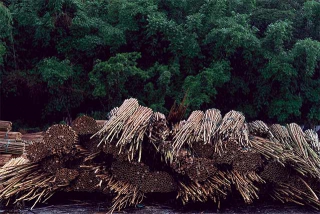
Bamboo materials piled up at Yuanli Cargo Yard ↑ Bamboo materials piled up at Yuanli Cargo Yard. In 1976, Taiwan's production reached 17.9 million units. In recent years, it has faced the crisis of industry exodus, capital and technology outflow, and industrial chain disruption.
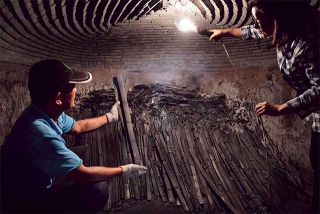
Bamboo charcoal kiln ↑ In the bamboo charcoal kiln, one-meter-long bamboo pieces are carbonized at a high temperature of 800℃, and fully refined bamboo charcoal is sifted out. It can be used as a textile material and has the function of shielding electromagnetic waves.
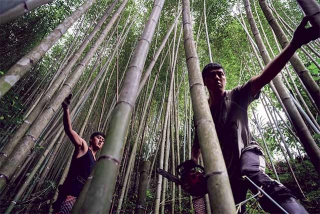
Thinning out a bamboo forest ↑ Ah Shan and his brother are thinning out a bamboo forest in Taoyuan. Bamboo forests require careful management. If bamboo is not harvested in a timely manner, the quality of the bamboo will deteriorate.
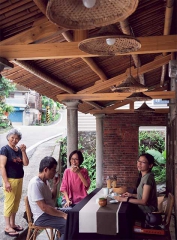
The foot of the pavilion with a bamboo roof ↑ Guilin Village, Gukeng Township, Yunlin, the foot of the pavilion with a bamboo roof, neighbors share a leisurely tea time together. The architects repaired the roof with new high-temperature dried bamboo, which not only retains the flavor of the old space, but also improves weather resistance.
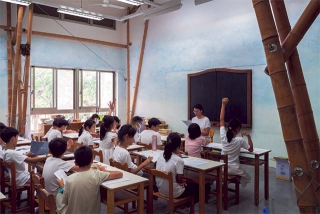
Simple and unadorned spatial form ↑ In the classroom filled with the sound of reading, a simple and unadorned spatial form is used to protect children’s senses, as if returning to the traditional dwellings that conform to local customs and practices.
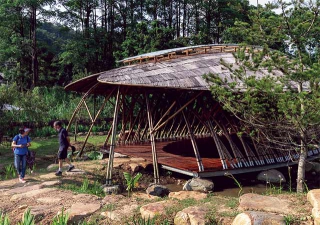
The Butterfly Dream Pavilion and the Dream Butterfly Pavilion in Taomi Ecological Village, Nantou ↑ The Butterfly Dream Pavilion and the Dream Butterfly Pavilion in Taomi Ecological Village, Nantou are based on blocks of stone, using natural bamboo and bamboo weaving structures, presenting the beauty of simple natural rhythm.
~The source of the information is part of the excerpt from the article of "Classic Magazine", used with permission~
Next > The future of bamboo construction The more you consume, the more environmentally friendly you are
Bamboo Knowledge Base Related Articles Extended Reading
